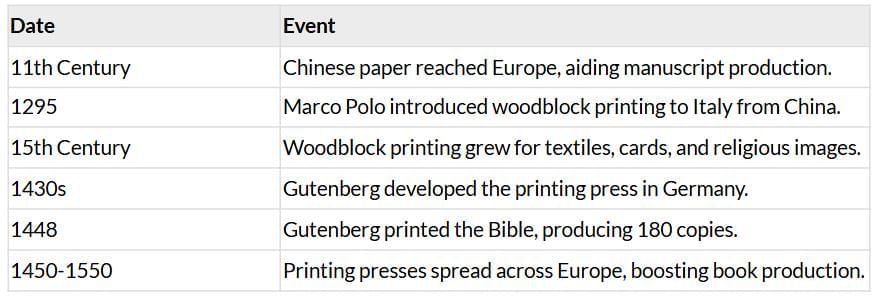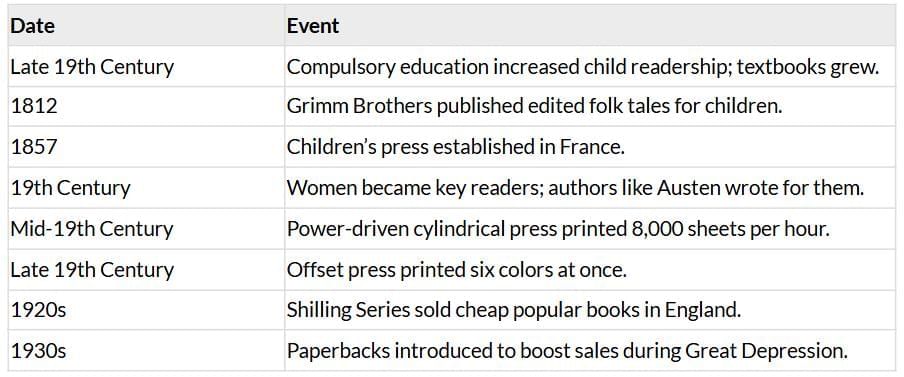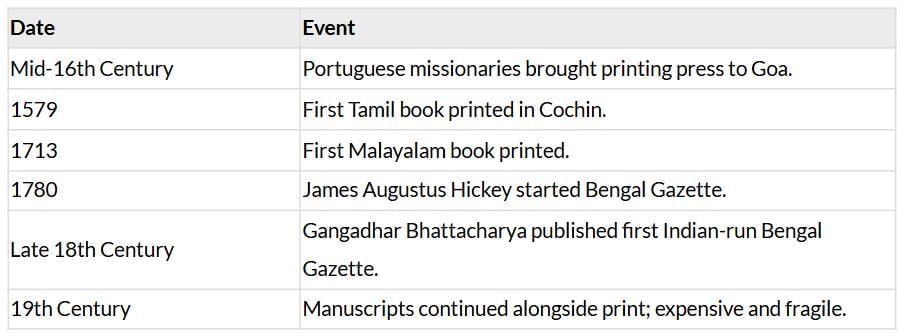Cheatsheet: Print Culture & the Modern World | Social Studies (SST) Class 10 PDF Download
Introduction
This cheatsheet summarizes the history of print culture, from its origins in East Asia to its spread in Europe and India. Print changed how people accessed knowledge, shaping education, debates, and society. Understanding this timeline is important because it shows how print created new reading publics and influenced social and political changes. The tables below list key dates and events for quick revision.
The First Printed Books
Print began in East Asia with hand printing in China, Japan, and Korea. In China, woodblock printing created books for exams and later for urban readers, including women. By the 19th century, mechanical presses arrived.
Key Points: Woodblock printing started in China, spreading knowledge. Print expanded to urban readers, and mechanical presses modernized printing by the 19th century.
Print in Japan
Buddhist missionaries brought hand printing to Japan. By the medieval period, books were cheap and common, with visual materials like paintings flourishing in urban areas like Edo.
Key Points: Hand printing from China reached Japan, making books affordable. Urban culture in Edo boosted visual and literary printing.
Print Comes to Europe
Chinese paper and woodblock printing reached Europe via trade. By the 15th century, Gutenberg’s printing press revolutionized book production, making books more accessible.
Key Points: Chinese paper and woodblock printing led to Europe’s print revolution. Gutenberg’s press made books cheaper and widely available.
The Print Revolution and Its Impact
The printing press created a new reading public and culture, blending oral and written traditions. It sparked religious debates, like the Reformation, but also raised fears of uncontrolled ideas.
Key Points: Printing created a reading public and fueled debates like the Reformation. Fears of rebellious ideas led to censorship efforts.
The Reading Mania
Rising literacy in Europe led to a surge in reading. New literature like chapbooks and periodicals spread ideas, while thinkers like Mercier saw print as a tool for progress.
Key Points: Literacy growth fueled reading demand. Cheap books and periodicals spread ideas, with print seen as a tool for progress.
Print Culture and the French Revolution
Print culture helped spark the French Revolution by spreading Enlightenment ideas, fostering debate, and criticizing the monarchy.
Key Points: Print spread revolutionary ideas, criticized monarchy, and fostered debate, contributing to the French Revolution.
The Nineteenth Century
Mass literacy grew, with new readers among children, women, and workers. Innovations like the offset press and serialized novels changed printing and reading habits.
Key Points: Literacy growth created new readers. Innovations like offset presses and cheap paperbacks, plus serialized novels, transformed publishing.
India and the World of Print
India had a manuscript tradition before print. The printing press arrived with missionaries, and Indian newspapers grew, sparking debates and new literary forms.
Key Points: Print arrived in India via missionaries. Indian newspapers grew, but manuscripts persisted due to cost and tradition.
Religious Reform and Public Debates
Print fueled religious and social debates in India, with newspapers and tracts spreading reformist and orthodox ideas to a wider public.
Key Points: Print enabled public debates on religion and reform, with newspapers like Sambad Kaumudi spreading ideas widely.
New Forms of Publication
Print introduced novels, visual art, and cartoons in India. Artists like Raja Ravi Varma and satirical cartoons shaped modern ideas and critiques.
Key Points: Novels, cartoons, and mass-produced images like Ravi Varma’s shaped modern Indian culture and social critique.
Women and Print
Print encouraged women’s reading and writing in India. Journals and novels highlighted women’s struggles, though conservative resistance persisted.
Key Points: Print boosted women’s literacy and expression, with novels and journals addressing their struggles despite opposition.
Print and the Poor
Cheap books and libraries made print accessible to the poor. Writings by reformers like Phule and Ambedkar addressed caste and class issues.
Key Points: Affordable books and libraries reached the poor. Reformers like Phule and workers like Kashibaba used print to fight injustice.
Print and Censorship
Colonial authorities censored print to control criticism, but nationalist newspapers grew, sparking protests against restrictions.
Key Points: Colonial censorship targeted critical voices, but nationalist newspapers resisted, fueling protests.
Conclusion
The history of print culture shows how printing transformed societies from East Asia to Europe and India. Starting with woodblock printing in China, it spread to Japan and Europe, where Gutenberg’s press made books widely available. Print created new reading publics, sparked debates like the Reformation and French Revolution, and empowered women and the poor in India through literature and newspapers. Despite censorship, print drove social and political change, shaping the modern world by spreading ideas and fostering progress.
|
88 videos|630 docs|79 tests
|
FAQs on Cheatsheet: Print Culture & the Modern World - Social Studies (SST) Class 10
| 1. What were the significant features of the first printed books and how did they influence society? |  |
| 2. How did print culture develop in Japan and what were its key characteristics? |  |
| 3. What was the impact of the print revolution on European society and culture? |  |
| 4. In what ways did print culture contribute to the French Revolution? |  |
| 5. How did print culture affect religious reform and public debates in various societies? |  |
















